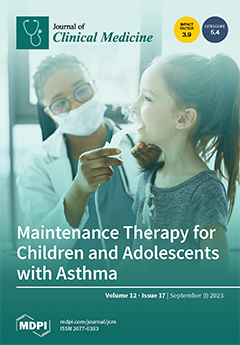Extremely low birth weight (ELBW) premature infants are particularly susceptible to hypocarbia and hypercarbia, which are associated with brain and lung morbidities. Transcutaneous CO
2 (TcCO
2) monitoring allows for continuous non-invasive CO
2 monitoring during invasive and non-invasive ventilation and is
[...] Read more.
Extremely low birth weight (ELBW) premature infants are particularly susceptible to hypocarbia and hypercarbia, which are associated with brain and lung morbidities. Transcutaneous CO
2 (TcCO
2) monitoring allows for continuous non-invasive CO
2 monitoring during invasive and non-invasive ventilation and is becoming more popular in the NICU. We aimed to evaluate the correlation and agreement between CO
2 levels measured by a TcCO
2 monitor and blood gas CO
2 (bgCO
2) among ELBW infants. This was a prospective observational multicenter study. All infants < 1000 g admitted to the participating NICUs during the study period were monitored by a TcCO
2 monitor, if available. For each bgCO
2 measured, a simultaneous TcCO
2 measurement was documented. In total, 1828 pairs of TcCO
2–bgCO
2 values of 94 infants were collected, with a median (IQR) gestational age of 26.4 (26.0, 28.3) weeks and birth weight of 800 (702, 900) g. A moderate correlation (Pearson: r = 0.64) and good agreement (bias (95% limits of agreement)):(2.9 [−11.8, 17.6] mmHg) were found between the TcCO
2 and bgCO
2 values in the 25–70 mmHg TcCO
2 range. The correlation between the TcCO
2 and bgCO
2 trends was moderate. CO
2 measurements by TcCO
2 are in good agreement (bias < 5 mmHg) with bgCO
2 among premature infants < 1000 g during the first week of life, regardless of day of life, ventilation mode (invasive/non-invasive), and sampling method (arterial/capillary/venous). However, wide limits of agreement and moderate correlation dictate the use of TcCO
2 as a complementary tool to blood gas sampling, to assess CO
2 levels and trends in individual patients.
Full article






